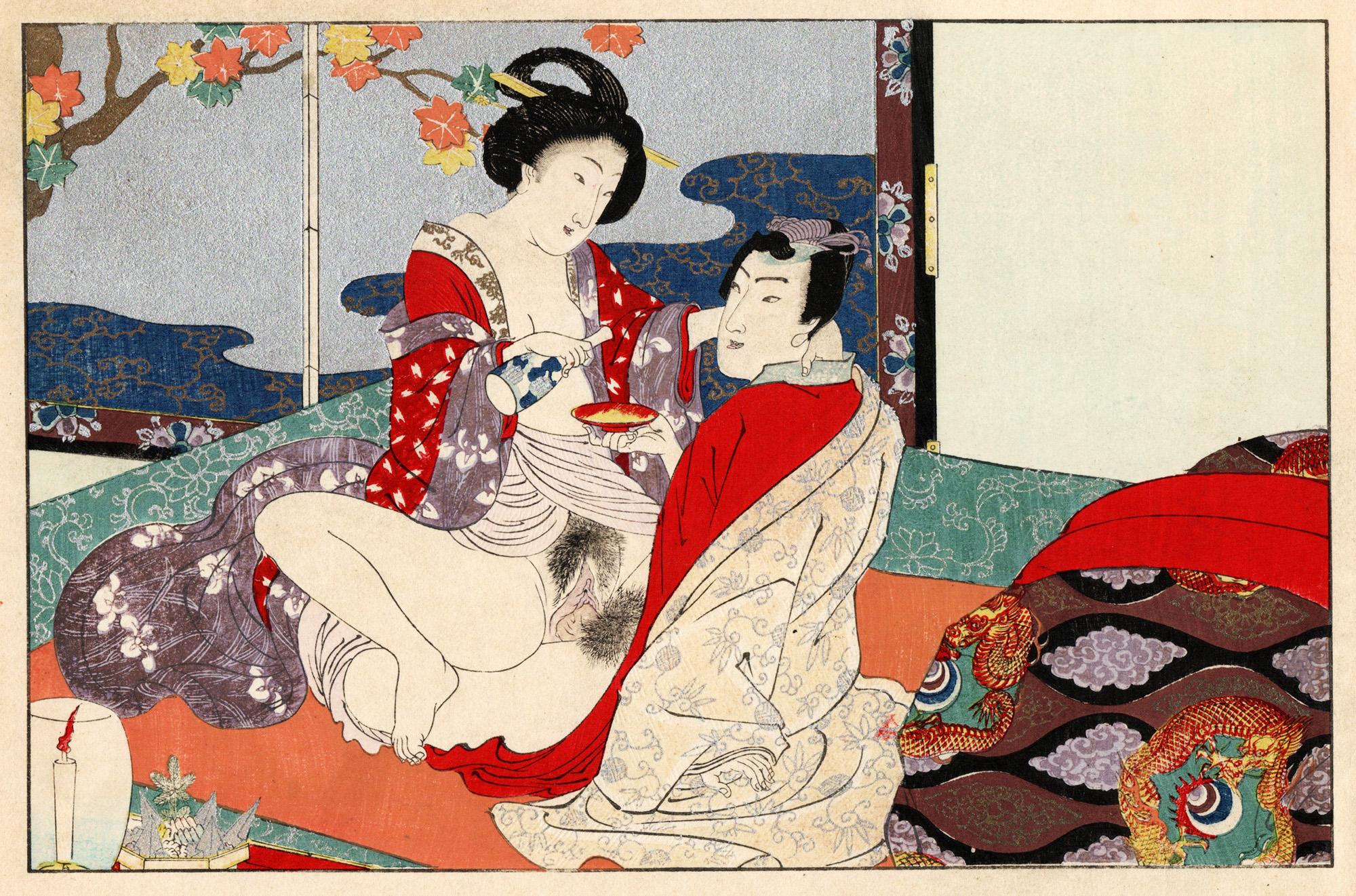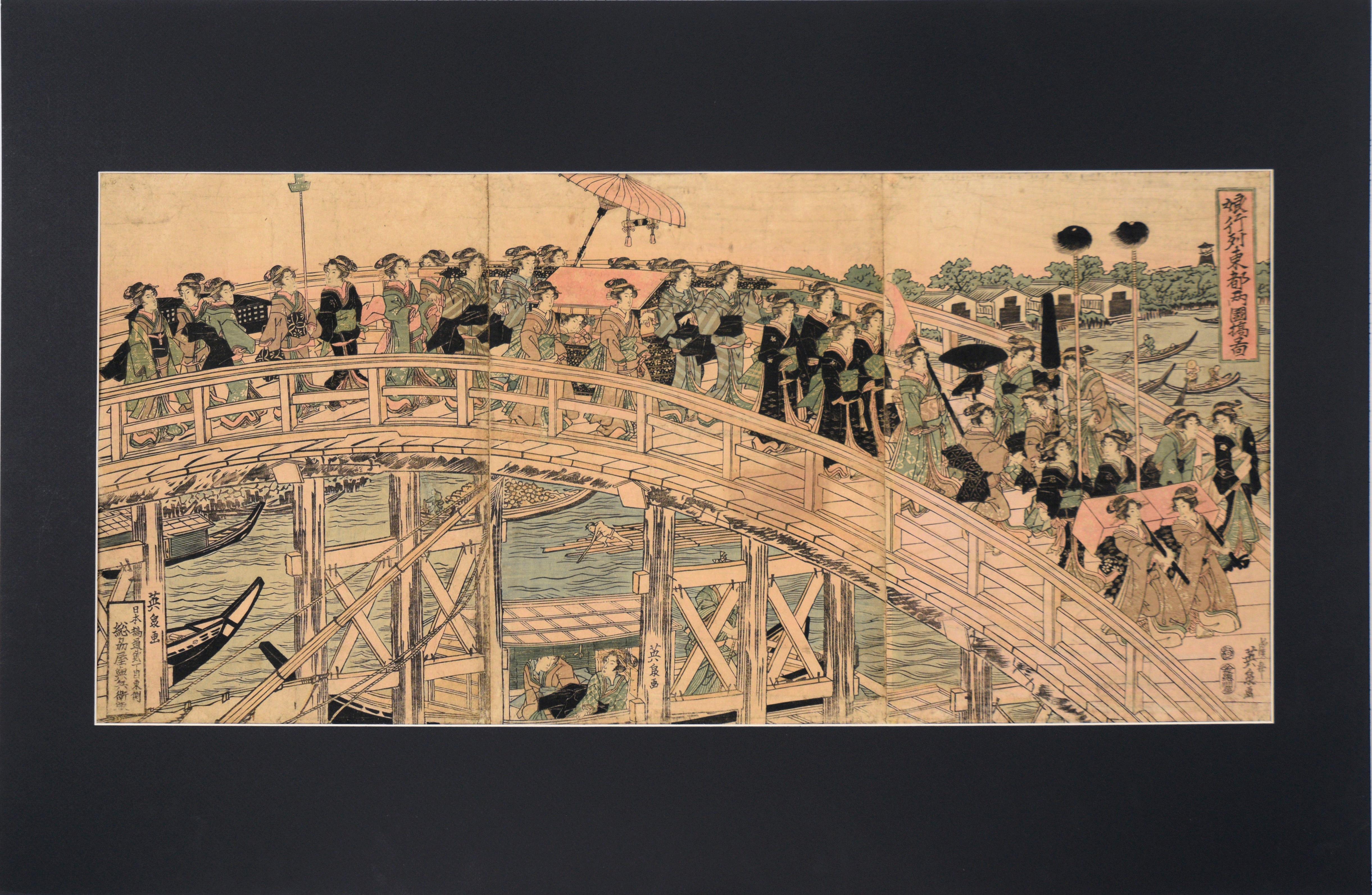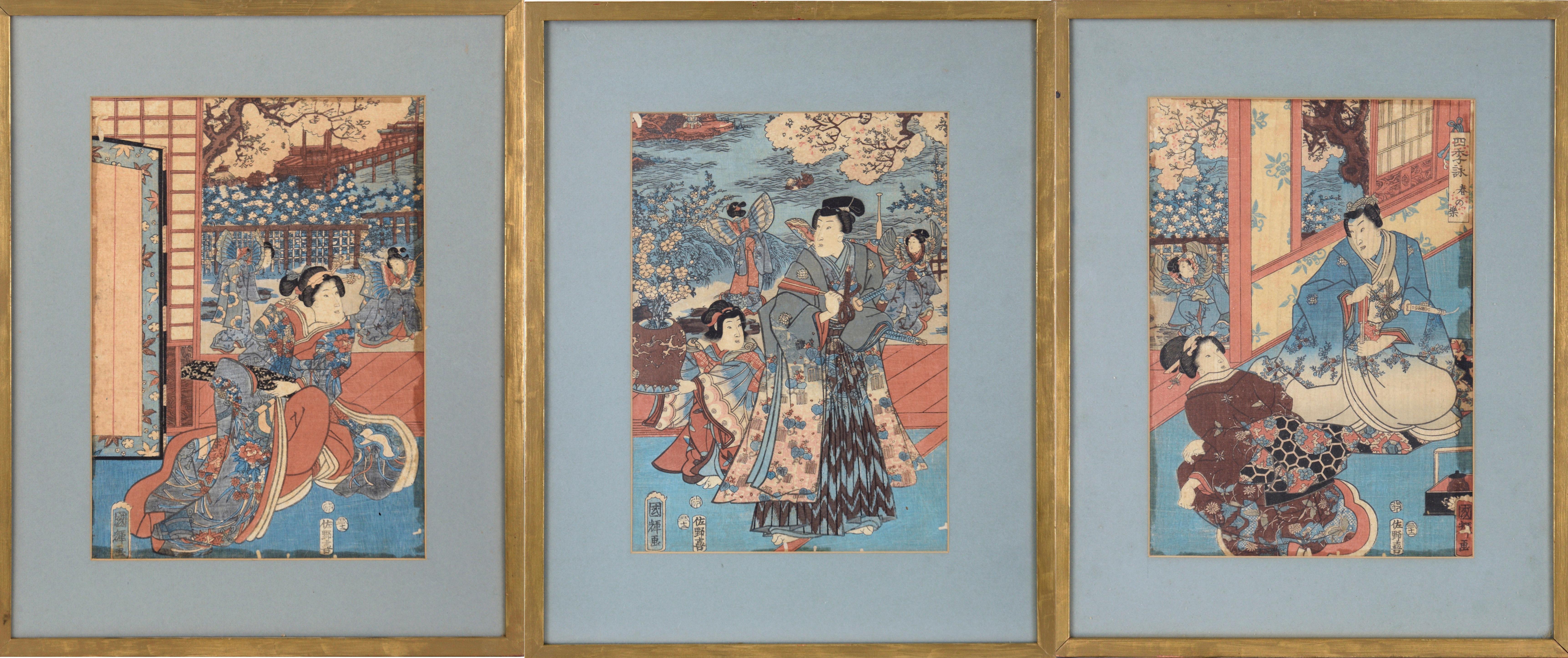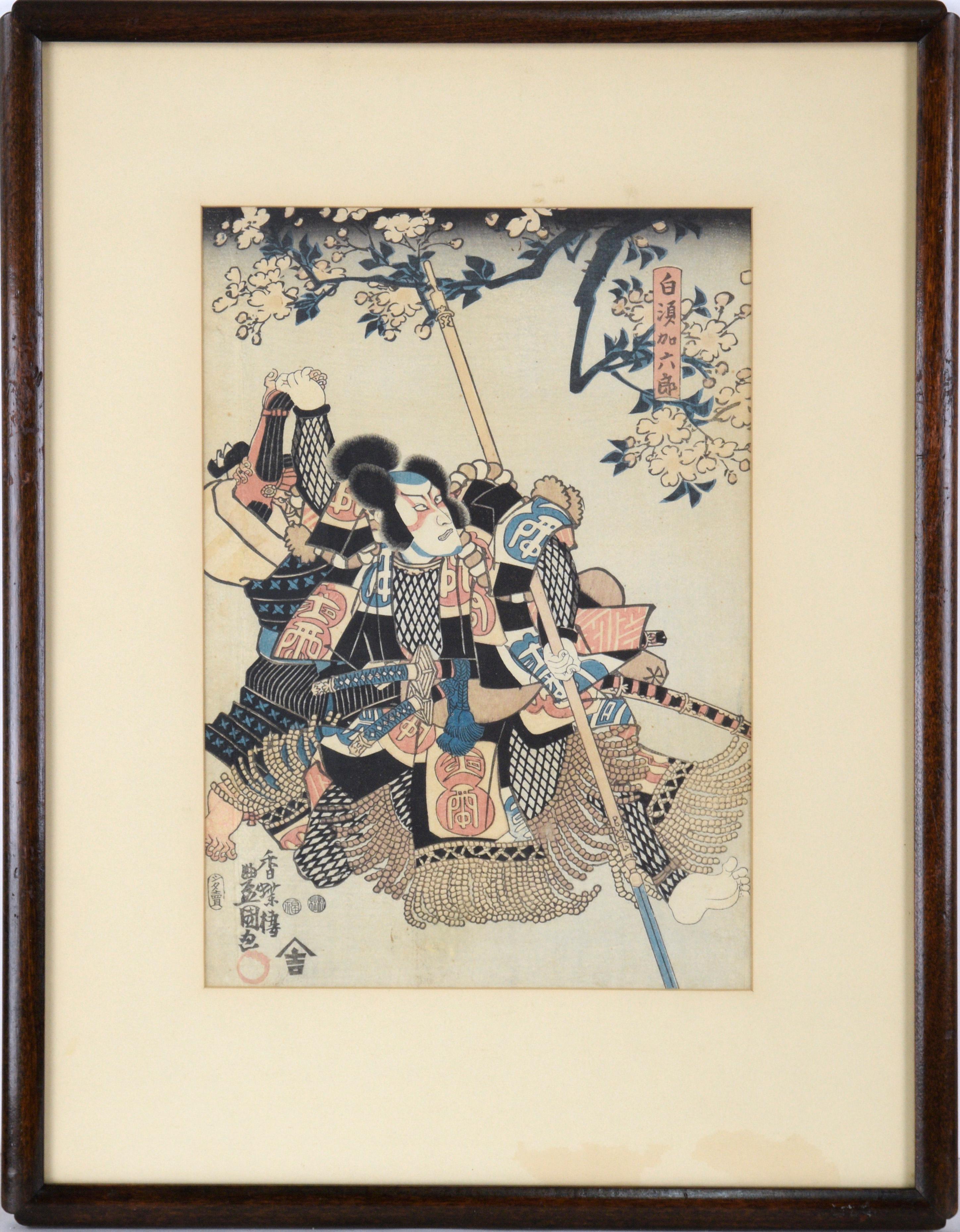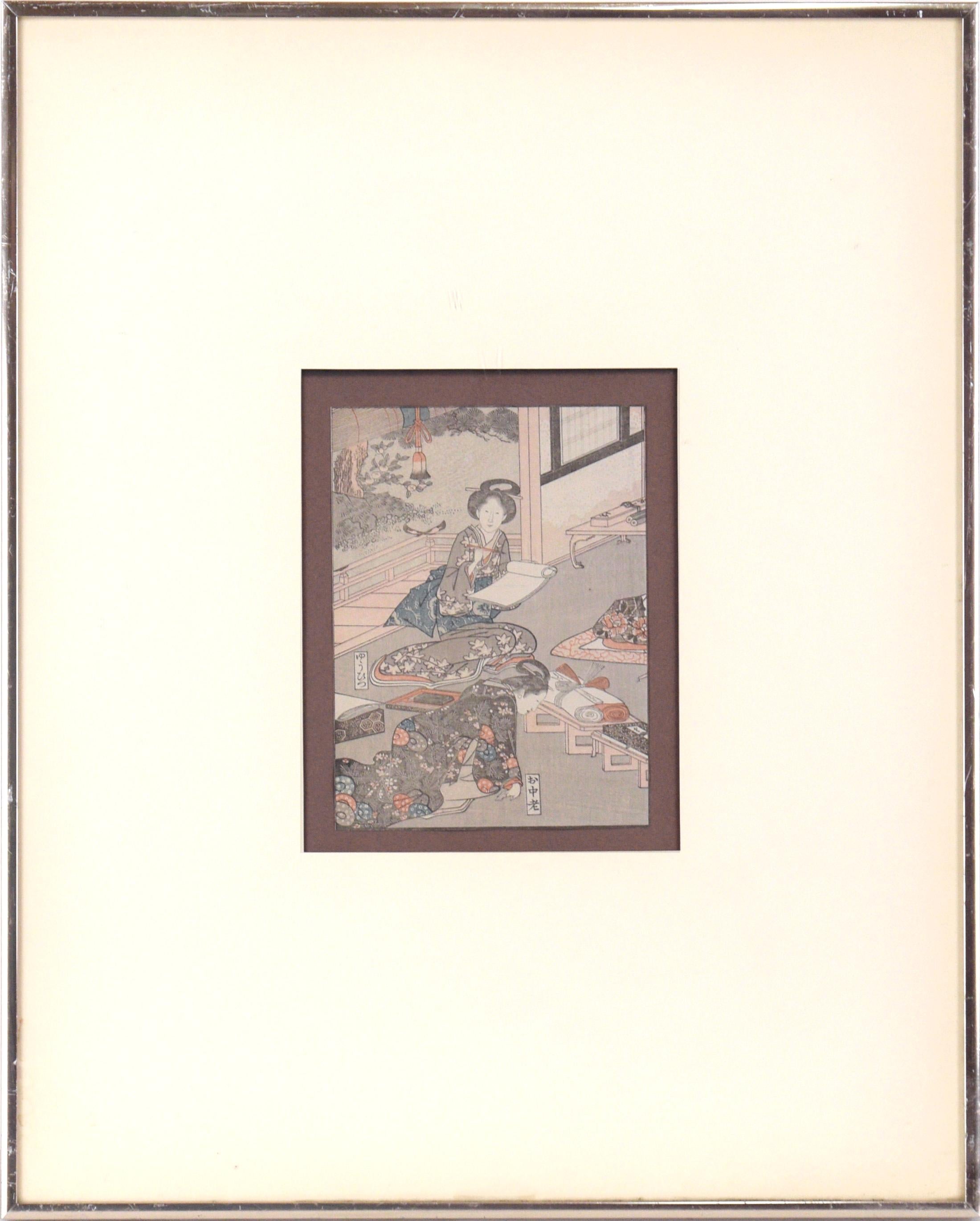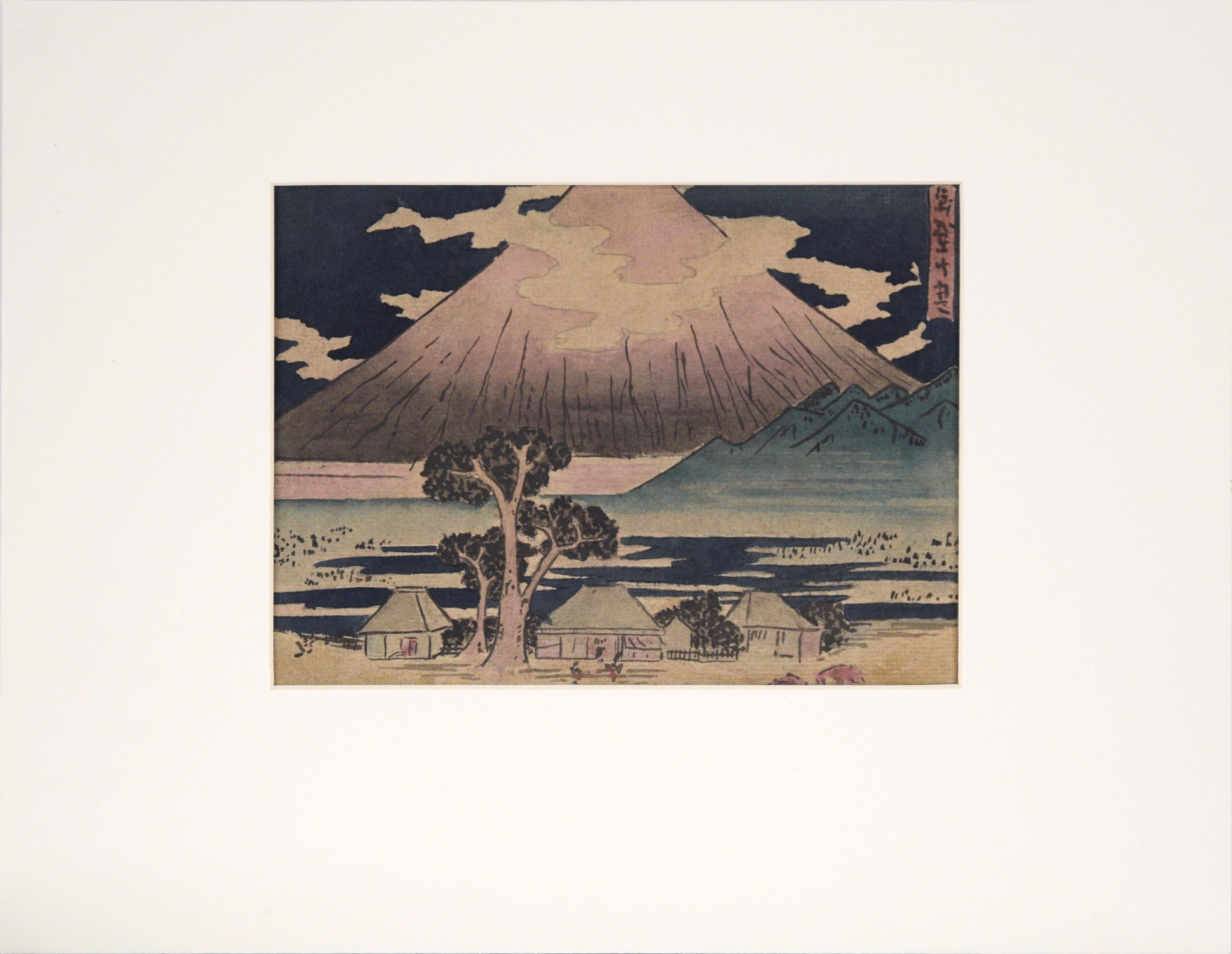Items Similar to Actor Arashi Rikan II as Aburaya Yohei - Figurative Woodblock Print on Paper
Want more images or videos?
Request additional images or videos from the seller
1 of 15
Shunbaisai HokueiActor Arashi Rikan II as Aburaya Yohei - Figurative Woodblock Print on Paper1836
1836
About the Item
Actor Arashi Rikan II as Aburaya Yohei - Figurative Woodblock Print on Paper
Woodblock print of kabuki actor by Shunbaisai Hokuei (Japanese, d. 1837). The actor is an oil seller, leaning against two large barrels suspended on a rod. The play "Aburauri Kuruwa Banashi" (The Story of an Oil-seller in the Pleasure Quarter) was performed at the Naka Theater in 1836.
Shunbaisai Hokuei (Japanese, d. 1837), also known as Shunkō III, was a designer of ukiyo-e style Japanese woodblock prints in Osaka, aOsaka andive from about 1824 to 1837. He was a student of Shunkōsai Hokushū. Hokuei’s prints most often portray the kabuki actor Arashi Rikan II. Working for only nine years, Hokuei nevertheless dominated the production of actor prints, especially during the years 1832-36, when he accounted for roughly 60 percent of all prints published in Osaka.
Many of Hokuei's prints were technical marvels employing advanced block-cutting and printing techniques. He often used a tension-filled dramatic approach toward much of his actor portraiture, sometimes positioning isolated figures against monochromatic backgrounds to emphasize the actors' expressions and emotional states. He experimented with unusual placements of solitary figures, which when combined with articulated gestures, postures, and facial expressions resulted in a notable body of work. Hokuei also arranged solitary figures to suggest related action beyond the confines of the single sheet, which added a sense of uncertainty and dramatic possibility that tempted the viewer to fill in the missing narrative.
- Creator:Shunbaisai Hokuei (Japanese)
- Creation Year:1836
- Dimensions:Height: 21.5 in (54.61 cm)Width: 16.5 in (41.91 cm)Depth: 0.5 in (1.27 cm)
- Medium:
- Movement & Style:
- Period:
- Condition:Some fading and age toning to paper, as expected. Two small spots of discoloration at bottom edge.
- Gallery Location:Soquel, CA
- Reference Number:
About the Seller
5.0
Platinum Seller
These expertly vetted sellers are 1stDibs' most experienced sellers and are rated highest by our customers.
Established in 1986
1stDibs seller since 2014
2,515 sales on 1stDibs
Typical response time: <1 hour
- ShippingRetrieving quote...Ships From: Soquel, CA
- Return PolicyA return for this item may be initiated within 14 days of delivery.
More From This SellerView All
- Mitate of a Daimyo's Procession Crossing Ryogoku Bridge - Woodblock PrintBy Keisai EisenLocated in Soquel, CAMitate of a Daimyo's Procession Crossing Ryogoku Bridge - Woodblock Print Woodblock print of a procession by Keisai Eisen (Japanese, 1790–1848). Terrific triptych of a procession of...Category
Early 19th Century Edo Figurative Prints
MaterialsWoodcut, Rice Paper, Ink
- Scribe and Personal Assistant to the Shogun - Japanese Woodblock Print on PaperLocated in Soquel, CAScribe and Personal Assistant to the Shogun - Japanese Woodblock Print on Paper Detailed woodblock print by an unknown artist, In the style of Suzuki Harunobu. There are two women i...Category
19th Century Edo Figurative Prints
MaterialsPaper, Ink, Woodcut
- "Shirasuka Rokuro" - Mid 19th Century Figurative Japanese Woodblock PrintBy Utagawa Kunisada (Toyokuni III)Located in Soquel, CA"Shirasuka Rokuro" - Mid 19th Century Figurative Japanese Woodblock Print Beautiful mid 19th century figural Japanese woodblock print of a samurai named Shirasuka Rokuro by Utagawa Toyokuni III (Kunisada) (Japanese, 1786-1864/5). The samurai is holding a spear, standing under a tree with full blossoms. He is wearing an elaborate outfit, including two swords. Artist's signature and chop are in the lower left corner of the piece. Presented in a wood frame with a cream mat. Frame size: 21.5"H x 16.5"W Image size: 13.75"H x 9.5"W During his lifetime Kunisada Utagawa was considered to be the best print designer by his contemporaries. He was more popular than Hiroshige, Hokusai or Kuniyoshi. And Kunisada was extremely productive. His total output is estimated at more than 20,000 designs, many made by his students. Kunisada was born near Edo (today Tokyo) as the son of an affluent merchant with a ferry boat license. At the age of fifteen he joined the famous art school of Utagawa Toyokuni and took the name Kunisada. In 1807 the young artist produced his first illustrated book. And in 1808 his first actor prints were published. His fame grew fast. While other artists like Kuniyoshi Utagawa or Hiroshige had to fight for recognition for years, he was successful from the beginning. He should become the most commercially successful of all woodblock printmakers ever. His early success may not have had a good influence on his personality. He had a reputation for his conceited personality. Kunisada designed a wide spectrum of traditional ukiyo-e subjects like kabuki themes, beautiful women, historical events and quite a few shunga...Category
1850s Edo Figurative Prints
MaterialsPaper, Ink, Woodcut
- The Four Seasons: Spring Japanese Woodblock Triptych ink on Paper Tales of GenjiLocated in Soquel, CAThe Four Seasons: Spring - Japanese Woodblock Triptych in Ink on Paper Colorful kabuki scene by Utagawa Kuniteru (Japanese, active 1818-18...Category
Early 19th Century Edo Figurative Prints
MaterialsPaper, Ink, Woodcut
- Study of Utagawa Hiroshige's "View of Hara-Juku" 53 Stations of the Tokaido RoadBy Utagawa HiroshigeLocated in Soquel, CAStudy of Utagawa Hiroshige's "View of Hara-Juku" 53 Stations of the Tokaido Road Hand painted study of Utagawa Hiroshige's "View of Hara-Juku", (by unknown artist), from "53 Station...Category
1920s Edo Landscape Prints
MaterialsWoodcut, Paper, Ink
- "Enshoku Sanju-roku Kasen" (Thirty-six Enchanting Flowers) Woodblock on paperBy Toyohara KunichikaLocated in Soquel, CA"Enshoku Sanju-roku Kasen" (Thirty-six Enchanting Flowers) Woodblock on paper Elegant woodblock print by Toyohara Kunuchika (Japanese, 1835-1900). Three women are in talking with each other inside, while a man waits outside holding a bag of some kind. The colors in this piece are rich and saturated, primarily blues, greens, and purple. Mat size: 16"H x 20"W Paper size: 14.75"H x 9.88"W Born in 1835, Toyohara Kunichika grew up in the Kyobashi district of Edo in the midst of merchants and artisans. In 1848, at age 13, he was accepted as an apprentice into the studio of Utagawa Kunisada I...Category
1880s Edo Figurative Prints
MaterialsInk, Rice Paper, Woodcut
You May Also Like
- Seishi Ai-oi Genji – Set of 12 Shunga works together w/astrological commentaryBy Utagawa Kunisada (Toyokuni III)Located in Middletown, NYSet of 12 woodblock prints in colors on handmade, laid mulberry paper, 6 3/4 x 10 1/4 inches (170 x 258 mm), printed in Ka-ei 4 (1851). Each print with minor handling wear, otherwise in excellent condition with bright and fresh color, and with details printed in silver ink. The images themselves contain several illusive characters indicating the publisher which are obfuscated by figures, as intended. Presented loose, as issued. A fine set. The astrological commentary print has a large and meandering blind stamp with a bird and palm frond motif. This print lists various phrases concerning the Twelve Zodiac Animals as historically counted in Japan, and appears to include erotic commentary on the traits of people born under each of the twelve signs. These Shunga images were issued in books that paralleled (in an erotic fashion...Category
Mid-19th Century Edo Nude Prints
MaterialsInk, Handmade Paper, Woodcut
- Actor Iwai Shigaku as Somenoi in "Denka chaya adauchi"By KuniyoshiLocated in Middletown, NYActor Iwai Shigaku as Somenoi in "Denka chaya adauchi" (Revenge at the Denka Teahouse), by Shigeharu, Ryusai (also called Kuniyoshi) Tokyo: Horie Ichiba Wataki, 1835. Woodcut on la...Category
Early 19th Century Edo Portrait Prints
MaterialsLaid Paper, Handmade Paper, Woodcut
- Drying PaperLocated in Middletown, NYWoodcut on cream laid paper, 7 1/4 x 2 1/2 inches (182 x 63 mm), narrow margins. Laid down to non-archival board with scattered soiling and some adhesive staining. Okumura Masanobu (Japanese 1686 – 13 March 1764) was a Japanese print designer, book publisher, and painter. He also illustrated novelettes and in his early years wrote some fiction. At first his work adhered to the Torii school, but later drifted beyond that. He is a figure in the formative era of ukiyo-e doing early works on actors and bijin-ga ("pictures of beautiful women"). While Masanobu's early life is largely undocumented, he is believed to have been born about 1686, possibly in Edo (modern Tokyo). Edo was a small fishing village when Tokugawa Ieyasu chose it as his administrative capital of the Tokugawa shogunate, and by the early 17th century the city had prospered and its population had grown to half a million. Masanobu appears to have been self-taught painter (though he did study poetry under Tachiba Fukaku); he is not known to have belonged to any artistic school. His early work shows the influence of the Torii school of ukiyo-e painting...Category
Early 18th Century Edo Figurative Prints
MaterialsHandmade Paper, Woodcut
- 'Hare, from Twelve Zodiac Signs' woodblock print by Utagawa KuniyoshiBy Utagawa KuniyoshiLocated in Milwaukee, WIThis print is from a highly regarded series by the Edo woodblock artist Utagawa Kuniyoshi: in the period, there were at times prohibitions in depicting a...Category
1850s Edo Figurative Prints
MaterialsPaper, Pigment, Woodcut
- Beauties on the Beach with view of Mount FujiBy Yoshu ChikanobuLocated in Burbank, CAShichirigahama, Sagami Province. A beauty in the foreground waves to her young companions, who run towards her on the beach. The beauty at left wears a western-style golden ring. We ...Category
1890s Edo Landscape Prints
MaterialsHandmade Paper, Mulberry Paper, Woodcut
- Japanese Beauties Enjoy a Full MoonBy Utagawa Kunisada (Toyokuni III)Located in Burbank, CA"Sun, Moon and Stars". Three beauties enjoy a full moon on the veranda of a teahouse or restuarant. The woman on the left kneels and adjusts her lavishly printed kimono. The beauty in the center has her hair down, and behind her is a screen against which shadows are beautifully silhouetted, which adds an air of mystery. The seated woman on the right is perhaps a geisha, as we see a shamisen lying next to her. Before her is a tray with an assortment of foods. One may surmise that the beauties are being compared to the sun, the moon, and the stars. On the left we glimpse a full moon shining over the peaceful bay, and boats at harbor. Original first edition Japanese color woodblock print triptych...Category
1840s Edo Figurative Prints
MaterialsMulberry Paper, Woodcut
Recently Viewed
View AllMore Ways To Browse
Sap Bucket
Sara Zielinski On Sale
Sarah Slappey
Shigeki Kuroda
Siemen Dijkstra
Smiley Tiffany
Stanislas Lepri
Stanley Grosse
Stanley Roy Badmin, R.W.S, R.E., A.I.A., F.S.I.A. On Sale
Statue Femme Nue
Susan Mcgovney Hansen
Szabo Vladimir
Takahashi Hiromitsu
Theodore Casimir Roussel On Sale
Tiffany Smiley Signs
Titti Garelli
Toshiro Mifune
Vadik Suljakov
